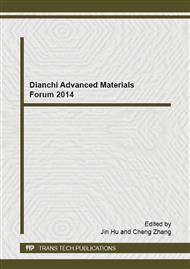p.89
p.93
p.97
p.102
p.107
p.113
p.118
p.122
p.127
Structural and Magnetic Properties of New Type CaxSr1-x-yLayO•nFe(2n-z)/nCoz/nO3 Magnets
Abstract:
Considering that Ca2+ has the similar ion radius and the substituted ability as Sr2+ and Ba2+ but the same family, CaxSr1-x-yLayO•nFe(2n-z)/nCoz/nO3 ferrites have been synthesized by the conventional ceramic process. Structure and magnetic properties of CaxSr1-x-yLayO•nFe(2n-z)/nCoz/nO3 compounds have systematically been investigated by X-ray diffraction (XRD), vibrating sample magnetometer (VSM), scanning electron microscope (SEM) and B-H hysteresis curve measurements. Several compositions are selected to investigate the formation of M phase with the joint replacement of Ca-La-Co. It is found that the formation mechanism is based on the replacement of Sr2+ by La3+ plus Ca2+ and the charge compensation by Co2+. In futher results, the unexpectedly intrinsic coercivity of 436 kA/m and residual flux density of 0.445 T were obtained. In terms of material preparation, we believe that CaxSr1-x-yLayO•nFe(2n-z)/nCoz/nO3 is effective in the production of future high energy permanent magnets.
Info:
Periodical:
Pages:
107-112
Citation:
Online since:
November 2014
Authors:
Keywords:
Price:
Сopyright:
© 2014 Trans Tech Publications Ltd. All Rights Reserved
Share:
Citation:


